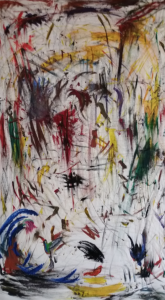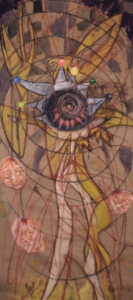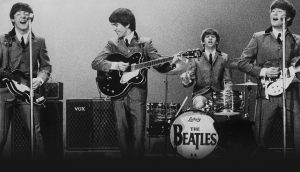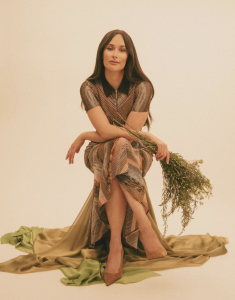Last updated on Nov 21, 2016
By Thomas Gillen
Arts & Entertainment Editor
The S.A.L. Gallery in the library and the Sculpture Building on the east side of campus, past the equestrian center, holds student art exhibitions throughout the year. While the Sculpture Building may be less known among students, it is the home of impactful classes, exhibitions and student work.

Student Artist, Ania Jn Pierre
Drawing, Painting and Sculpture for the Art Therapist is just one class taught in the Sculpture Building. “The Graduate Clinical Art Therapy Program consists of several courses from psychology, art therapy, multiculturalism, social action, counseling, studio art, thesis writing and internship field work courses,” said Ann Charlotte Tavolacci, an artist and adjunct professor in the graduate art therapy program. “For the past several years we have been giving students the option to do course work abroad as well. They have been to Korea and Nicaragua the last two years.”
Tavolacci’s Drawing, Painting and Sculpture for the Art Therapist is required for graduate art therapy first-year students; it is not currently open to other majors but “we may be adding a new course that is similar to ARTH 602 as an art elective open to other majors making for a multidisciplinary studio art course – ‘Personal Art Making for the Creative Thinker,’ ” she said. “This will explore other areas of personal art making, use a new text and explore different studio art making techniques.”
The course is “extremely personal,” as students “have to open up in the class because they will eventually have to do it once they become an art therapist,” Tavolacci added. “As an art therapist, they will have to ask someone to deal with issues in a similar way.”
The students in the class are given projects called “directives,” form of intervention using art. “With a directive, the art therapist has a goal in mind and uses art to talk about issues they are facing. They also help guide the student through the intervention,” Tavolacci said.
This is Tavolacci’s second year teaching the course, which she finds to be the most rewarding she’s taught. “This class gave me the opportunity to work with so many people in an intense capacity and is very invigorating and inspiring,” she said.
In addition to working on directives each week, the students also write a thesis, based on research with psychological perspectives. “It starts out personal and stretches out with research,” Tavolacci said.

Student Artist, Victor Franco
One of the changes she made from her first and second year of teaching the course revolved around how students presented their themes. “Last year, the students discussed their themes with me in a one-on-one session if it was therapeutic for them. Now, the students email me the themes, which I find to be more successful,” Tavolacci said, explaining that the email option seems to be working much like art therapy itself. The act of organizing their emotions this way becomes “cathartic” and processed through a controlled outlet, according to Tavolacci.
Thus, face-to-face discussions in the studio from that point are easier, as the personal content is accessible and easier to process through the art making. “Sometimes initially in-person it is hard to get all your words out, so ‘to speak.’ I call this process ‘controlled extension.’ As the professor and art therapist, I need to make sure this process happens organically and allow students to share as they feel comfortable to do so.”
Midway through the semester, the Drawing, Painting and Sculpture for the Art Therapist class holds an exhibition based on the personal thesis themes. “The exhibition allows students to purge their entities before becoming an art therapist to protect clients,” Tavolacci said. This semester’s exhibition entitled, “Me, Myself, and My Dirty Laundry,” runs in the Sculpture Building from Nov. 15-21. The idea behind the theme is that students are cleaning out their dirty laundry and will display their finished work on clotheslines.
Victor D. Franco, a graduate art therapy student in the class, based his theme around the idea of growing up too fast. His work is, “centered on the ideation of ‘Premature Acceleration: Unexpected Roles and Burdens,’ ” he said. “This body of work explores personal fears that have arisen with growing up too fast, and the exploration of layers due to the belief that one self-actualizes through an onion-like ‘peeling’ process,” he added.
A reception will be held on Thursday, Nov. 17 from 6-8 p.m. and is open to the public.



Be First to Comment